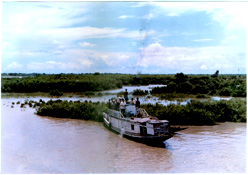 The Sunderbans, extending over an area of 1,000,000 hectares, is the world's largest delta, formed by the Ganges, Brahmaputra and Meghana rivers.The vast swampy delta extends over areas comprising of mangrove forests, swamps and forest island, all interwoven in a network of small rivers and streams. The Sundarbans National Park, home of the Royal Bengal Tiger and the largest mangrove forest in the world, form the core of this area. The Sundarban region has got its name from Sundari trees, once found in abundance here. The Sunderbans, extending over an area of 1,000,000 hectares, is the world's largest delta, formed by the Ganges, Brahmaputra and Meghana rivers.The vast swampy delta extends over areas comprising of mangrove forests, swamps and forest island, all interwoven in a network of small rivers and streams. The Sundarbans National Park, home of the Royal Bengal Tiger and the largest mangrove forest in the world, form the core of this area. The Sundarban region has got its name from Sundari trees, once found in abundance here.
The Ganges and the Brahmaputra form this alluvial archipelago of 54 islands watered by the Bay of Bengal. The islands Goasaba, Sandeshkali and Basanti form the northern boundary of the Sundarbans; on the south is the sea; to the west side of the Sunderbans park is the Matla and Bidya rivers and to the east is the international boundary of Bangladesh.
Fascinating life forms await you in this largest estuarine delta in the world. In April and May, the flaming red leaves of the genwa, edge the emerald islands. The crab like red flowers of the kankara and the yellow blooms of khalsi add to the dazzling display. As you penetrate into the forests of Sundarbans, this fairyland unfolds its mysterious beauty.
The Sunderbans forest is home to more than 400 tigers. The Bengal Tigers have adapted themselves very well to the saline and aqua environs and are extremely good swimmers. As you enter the adventurous wild land of the Sundarbans you'll be thrilled to see the chital dear and rhesus monkey. The aqua fauna of Sunderbans include variety of fishes, red fiddler crabs and hermit crabs.
There are crocodiles, which can be often seen along the mud banks. Sunderbans National Park is also noted for its conservation of the Ridley Sea Turtle. There's is a incredible variety of reptiles also found in Sundarbans, which includes king cobra, rock python and water monitor. The endangered river Terrapin, Batagur Baska is found on the Mechua Beach, while the Barkind Deer is found only in Holiday Island in Sunderbans.
Sunderbans National Park
The Sajnakhali Sanctuary, famous for its rich avian population, is regarded as a part of the Sunderbans National Park. The kingdom of birds at Sajnekhati enchants your eyes. The most sought after sights by a bird watcher are seven colourful species of Kingfisher, white-bellied Sea Eagle, Plovers, Lap-Wings, Curfews, Sandpipers and occasional Pelican.
At Netidhopani, the ruins of a 400 year old temple and legends lend mystery to the atmosphere. Bhagabatpur is famous for having a hatchery of the largest estuarine crocodiles in the world. Kanak is the nesting place of the Olive Ridley Turtles. Haliday island is famous as last retreat of Barking Deer in India. |

